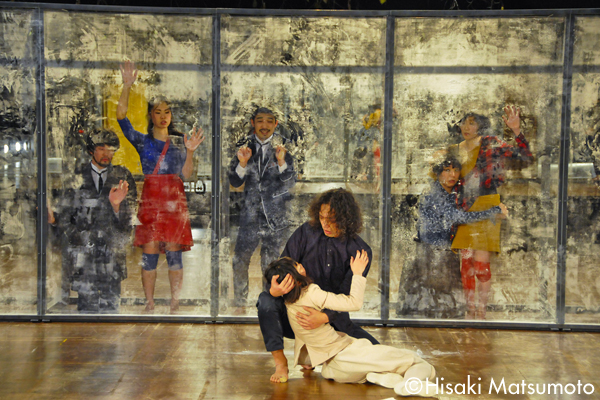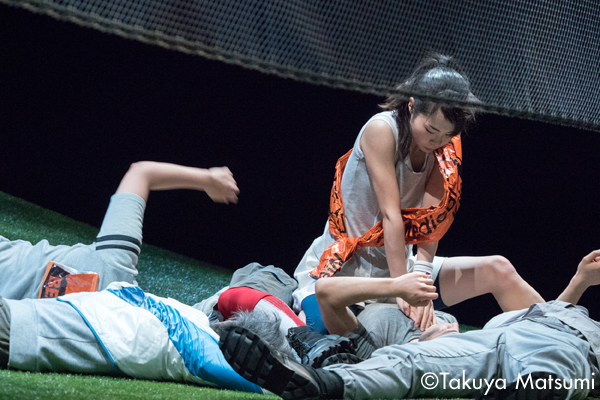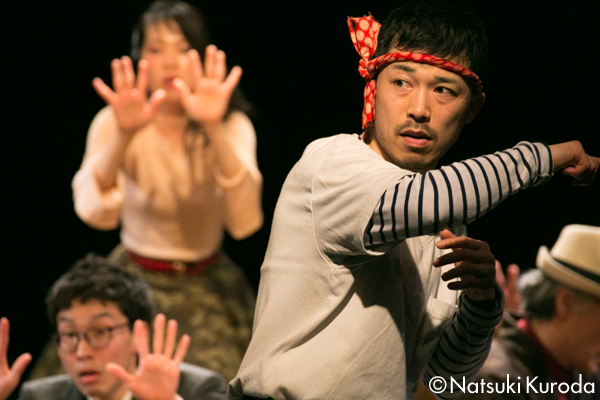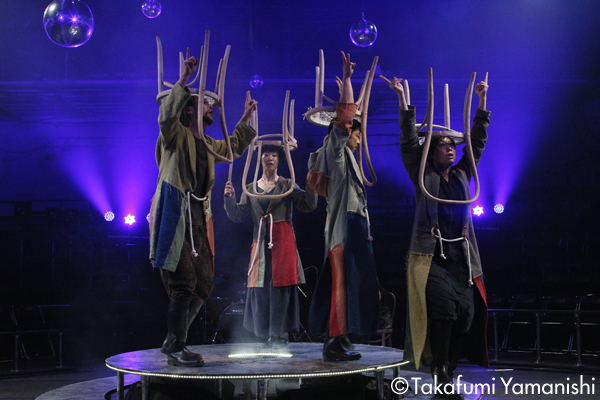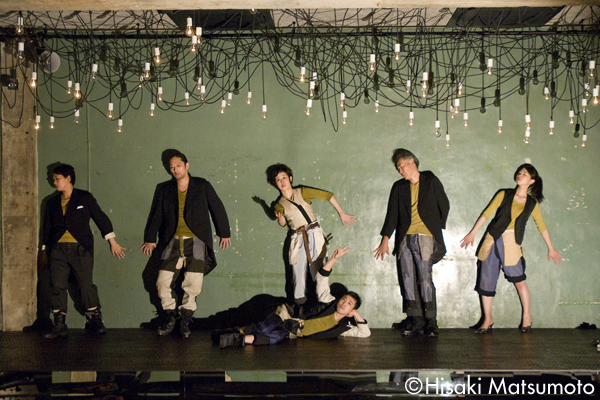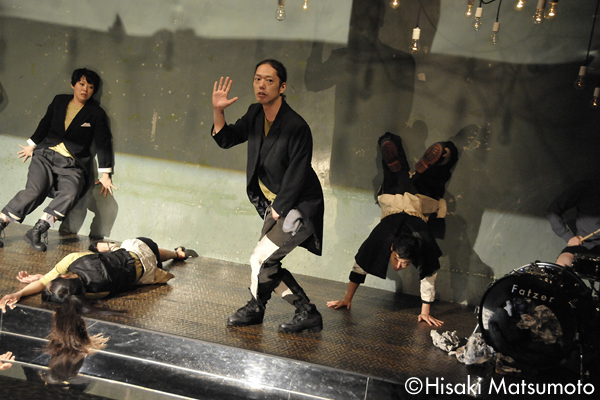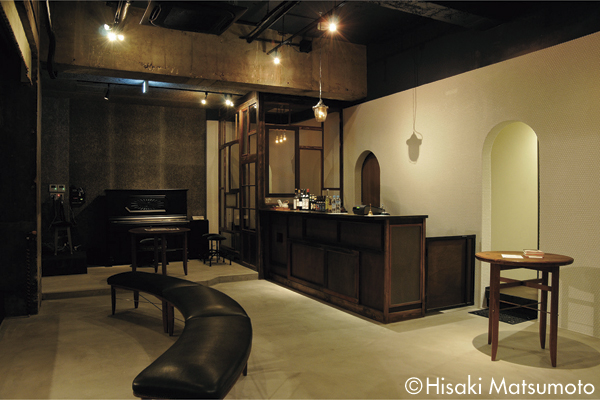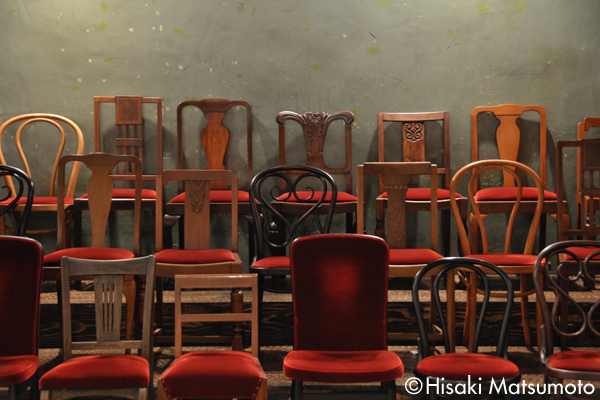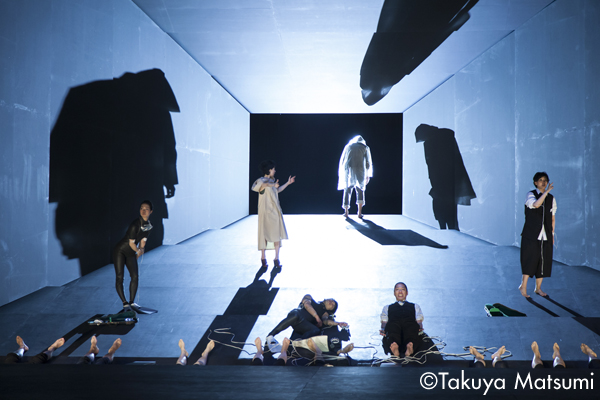Activities at UNDER-THROW
- The last time you had an interview with us for PANJ was in 2010. After that you opened a studio named UNDER-THROW in Kyoto in July of 2013. Would you begin by telling us about the things that led up to that move?
- After moving to Kyoto, we needed a space to keep our stage sets and such, so we rented a warehouse in Ritto city in neighboring Shiga Prefecture, but eventually it filled up and we needed more space. It was also a big job to go all the way there and bring back the sets whenever we re-staged one of our plays, so we were looking for a place that could serve as a stockyard for us in Kyoto, and it was at that time that we were shown the facility that is now our UNDER-THROW studio. We learned later that it was the same space that had been Kyoto’s legendary live-performance club Circus-Circus. After that, it became CBGB, which had been in business until ten years ago, but after that it had no tenant, so the basement space had basically been abandoned. When I saw it, I thought it was a space that could serve as a studio, so I negotiated with the owner and it was decided that we could rent it for half of the original renting rate. Once we got the studio, we also took that opportunity to incorporate our theater company (limited liability company), Then we got a loan and joined in the work of renovating it. The architectural design was done for us by the architect Junpei Kiz (*1), who did the stage art for our production Hikari no Nai (Kein Licht). The result was that, despite being theater-makers who originally had no connection with Kyoto whatsoever were still able to open a studio with no problems, thanks to the fortunate introductions of a number of people.
- When you were a member of the directing department at the Seinendan theater company, you experienced working on the staff of the Komaba Agora Theater. From that time, did you have a vision of having a theater company with its own studio and theater?
-
When I was on the staff at Agora, it was at a time when it was still renting out the theater for outside productions, but as a theater we wanted to quit that practice. Of course I am not against inviting guest performances of outside productions, but the basic format for a theater should be to serve as a place for the creation and performance of works by the artists who live there, and those works, in other words their repertoire (repertory), should be the theaters assets. That is the only true value of a theater for its audience.
This is also true for UNDER-THROW as well, but I believe that whether it is a municipal or prefectural or national theater, the basic format for any public theater should be to have an artistic director and a company of resident actors under its wing. Partly, it comes from the fact that that is the way things were around me when I was studying in France, but I believe that is the only way that theater can really develop artistically and prosper. When we first moved to Kyoto, the municipal Kyoto Arts Center was our base of activities and we didn’t have to pay to perform there, so I had a strong consciousness that in effect we were using tax money for our artistic activities. Now, with UNDER-THROW we are reluctantly operating as a private-sector theater, but I still believe that with our repertoire and all, we are operating on the public theater model.
Now that we actually have our own studio/theater, I am honestly surprised by the fact that we are able to rotate five or six repertoire works in the course of a year. I didn’t think we would be able to do this much. I am also pleased to see how the studio is functioning as a place where I can meet with and have exchanges with foreign presenters and artists, researchers and professionals from the Japanese theater scene much more actively and productively than I had expected. So, I am glad that we have been able to stand as an example of the public theater model that is quite rare here in Japan. And If I got an offer to serve as an artistic director at a real public theater, I would very much like to do that. - Would you tell us about the current state of activities at UNDER-THROW?
-
At UNDER-THROW we do studio work and rehearsals for new works in the afternoon, and then in the evening we have performance of our repertoire works at a set admission price (2,000 yen). We designed UNDER-THROW to include all the things necessary for interaction with our audience, like a bar and a cloak room. This has given me more opportunity to think about the audience (who are the real, independent supporters of the arts). This led us to undertake a two-year “Cultivation Program” (*2) project with funding from the Japanese Agency for Cultural Affairs. It was a program in which members of the audience were given the opportunity to view six of our plays at UNDER-THROW for free and then write an essay report about what they experienced. Those essays were then published in a collection and it turned out to be an interesting collection of writing about theater. Through this kind of initiative, I believe that we can see how the audience has naturally learned to watch and interact with contemporary theater.
As our next initiative, I am thinking of ways to train theater-makers, especially directors. It’s a project called Theater Bullpen and it consists of one year of actor workshops and staff work with lectures about running a theater, and the year ends with the group making one theater production. We have specific plans concerning the instructors and curriculum, but in terms of funding, we haven’t gotten what it will take yet. - What does cultivating audience involve?
-
Concerning audience, I have been thinking about it a lot recently. Although it is a question open to discussion, I believe that you can’t call your activities theater-making unless there is an audience. But, I believe that rather than saying, “I am audience,” it is more accurate if you say, “I become audience.” Through the act of going to the theater and watching a performance with other people (audience), you “become audience.” So, how to you “become audience?” I believe that the only way is to simply to watch the same performance with other people and, together with them, experience when they laugh and when they feel tension.
If you are armed with theoretical arguments or educate yourself about theater, you will tend to shut out that experiential aspect and search instead for interpretations that you already know or have already expounded. Rather than that approach, for example, in the case of CHITEN performances, many in the audience will say, “I don’t understand this,” but if there is someone next to you with the same initial, “I don’t understand this,” reaction and then suddenly something on stage makes you both laugh out loud, or something surprises you and makes you wonder what is going on, then you can experience together moments of realization. That ability, that strength of experiencing things together, of being in a place where you can experience realization that are outside the realm of you normal daily-life decisions and judgments, that is the process of “becoming audience.” I believe that is very important. It is the same for me, experiencing things like that makes you want to learn more, perhaps it will make you want to read the script to verify what you have seen, or it may make you want to read a critique and think about what was interesting in the performance. I think that is the most important educational experience that theater provides, and that is what becoming audience involves. In other words, becoming audience can involve accepting the differences in others, and if that theatrical viewpoint enables you to look at society in a new perspective, that is even better. - You have also started publishing a magazine called Chikashitsu (The Basement). Rather than the serialized novels published in many magazines, your magazine publishes serialized play scripts, and you feature contributions by a wide range of writers not limited to theater-makers.
-
We are still in the preparatory issue stage experimenting with contents, but by publishing a magazine I want to create a platform to at least inspire some more opportunities to think about the presence of UNDER-THROW and the presence of theater. Not in the framework of “UNDER-THROW = CHITEN = Theater” but in hopes of creating a magazine that shows that there is a large audience with people from a variety of professions who are thinking about a variety of issues. By doing the Cultivation Program I learned that in fact the audience is thinking about a lot of different things, and rather than just leaving it at that, I thought it would be good if our publication could become a platform for sharing these thoughts and stimulating discussion. By the way, two of the people presently on our UNDER-THROW editorial board are people who took part in the Cultivation Program. Since they aren’t necessarily people who are fully immersed in theater, they will put the brakes on me when I start trying to take everything off in the direction of theater (laughs).
Co-productions with Kanagawa Arts Theatre (KAAT)
- Since KAAT opened in Yokohama in 2011, CHITEN has done one co-production with KAAT each year (*3). These co-productions have brought larger scale to CHITEN works and expanded your theatrical world it seems.
-
KAAT seeks to be a creation-oriented “theater-making theater” and it technical staff in particular is of the highest level. They all have a consistently positive attitude toward their craft, which is very helpful from our standpoint. The [technical] staff work for our production of Jelinek’s (*4) Kein Licht (Japanese title: Hikari no Nai) commissioned by Festival/Tokyo (2012) was also done in collaboration with the KAAT staff.
In our co-productions with KAAT, the way we go about creating a work at CHITEN doesn’t change. We still compose the plays of key words selected on the single-word level, and all we do besides that is some “traffic direction” for the suggestions that come from the planners in that regard. However, the new creators we have worked with have had an important impact, and being introduced through KAAT to the architect Junpei Kiz as a stage art (set) designer has turned out to be a big new asset for CHITEN. Kiz-san is a very interesting person who will bring more than ten different patterns for set designs from the start and give a presentation using drawings with words of description included. The plans he brings are large in scale and as we look at them I see ones that present valid points and words in the presentation that seem to have positive possibilities, and together with the technical director we discuss them and gradually decide which we will use.
In terms of changes that have resulted in our theater-making from an artistic standpoint since beginning co-productions with KAAT, the costume designer Colette Huchard (*5) that KAAT introduced us to has had a definite impact. For our co-production of Three Sisters (Japanese title: Sannin Shimai) (2015), because of the amount of movement they must do around the set, the actors needed to use supporters, and the costumes Huchard created were wonderful, because they covered that problem in a non-conceptual way with everyday type clothing that also had a sense of eroticism. From the early stage of the creative work for that production she came to watch the studio work sessions even though she doesn’t speak Japanese. At one point she came to me and asked with a good amount of certainty, “The military men don’t have to look like military men, do they?” Without really much confidence, I nonetheless replied, “No, they don’t have to look military.” Thus she had successfully helped me to make the decision on that point. As a costume designer and theater-maker who has been educated thoroughly in the best traditions [in France and Belgium], she was able to take her knowledge of the original text and careful study of the physical attributes of the actors in the studio and quickly come up with ideas for the costumes. Having a partner like her to work with has definitely been a big asset, I am sure.
With Demons (Japanese title: Akuryo), we need to have snow falling continuously on stage, but for a small theater company like us that kind of difficult device is beyond our capability, it can only be done at a (large) public theater like KAAT. - Kein Licht was a wonderful production that brought together music of composer Masahiro Miwa (*6), stage art by architect Junpei Kiz, the play by CHITEN and the KAAT planners for lighting and sound. The stage set was designed like a giant rectangular tunnel that narrowed consistently toward the back of the stage and contained lighting that filled it with various degrees of light and shadow to create an other-worldly space. There was a chorus housed in a chorus pit at the front of the stage in which the chorus lay (with only their bare feet showing toward the audience), and using an arithmetic system of paper, scissors and stone progressions proposed by Miwa, they produced a harmony that was also other-worldly. The words of Jelinek’s play reverberated with the unique broken vocal delivery of the CHITEN actors. The total effect was like watching a grand-scale contemporary opera.
-
When we were doing Chekhov plays, I found it quite difficult to break out of the literary style defined by the harsh realism of the story. If a play is staged with one actor for each role, it becomes a case of the actor believing, “I am Hamlet,” so I asked myself how can this be different from straightforward realism, and that led me to try my best to upset that pattern in different ways. But with Jelinek’s plays, she begins by overturning all of the conventions of modern theater, which I found very interesting.
I had been introduced to the composer Miwa-san through Festival/Tokyo, and with him I found that I could collaborate with a musician with no unnatural feeling, and I had a strong sense that everything came together naturally. Since Miwa-san is a composer, I would write a tentative part and have him watch it being worked on in the studio (with the actors) and we could discuss a number of points until the concept came together. One time he said, “I will do this with an arithmetic system (equation),” and, from my standpoint, with that the music was immediately decided. He gave me a number of chorus patterns and I would work them into the play. Then, together we could made one variation after another. Music is an art with a strong temporal element, and when I work with a musician or a composer it is always with the same feeling as working with (stage) sound (acoustics); I believe that is why I can work with no unnatural feeling.
However, having a live chorus on stage is clearly not realism and it feels strange, so I took it as a new directorial challenge and thought about how to put the chorus on the stage, including how to treat the visual aspect, whether to show it or hide it. Because the way you show it (on stage) has a big effect on the structure of the play.
For Miwa-san, conceptual aspects, such as a connection with the Fukushima nuclear power plant accident in the case of Kein Licht and the Tokyo Olympics in the case of A Sport Play, are an important part of what drives, what motivates his creation. You can’t hear those connections at all when you listen to the music, but for example, with the Jelinek play, when you have a Geiger counter, he is quick to pick up on its sound and use it in his work so that it catches the ear of the audience. Rather than simply being an actuality, it is part of Miwa-san’s reading/interpretation of the text and his humor and literary sense, and as a director, I can enjoy that aspect and it makes me feel that I am fortunate to be working with him. - From what you say, it sounds like your creative process is a group effort in which you take suggestions from your planners and then consolidate them. May I ask what the job of directing means to you?
-
If I were to liken it to something, I think it is like deciding how to arrange the furniture in a building. For this particular production, you decide whether it will be set in a 40-year-old wooden apartment building or a high-class modern condominium, and then depending on what the building is like you quickly decide your decorating direction. If you have a choice between a 100 year-old antique table or a new one from a discount mass-market store like Nitori, there will always be a moment in some scene when the Nitori table will work well. And with that in mind, it is then a process of deciding how to place the other furniture, I believe. In the process there will be various aesthetics at work and you don’t waver in your choice of aesthetic. At the moment when the difference in the aesthetic suddenly comes in, everyone is surprised, and you have a feeling that you are sure you got it right. In that sense, there is not something specific that you want to do, but you are unwavering about what you should do.
The CHITEN Creative Process
- How do you choose your next productions or the author you will use? After you did the four major works of Chekhov, it seems like you have gone through the “dictionary of theater,” choosing the worlds of writers like Jelinek, Brecht and Mayakovsky, and you have brought in experts and researchers to be involved.
-
I think that the success of doing the four great plays of Chekhov in succession has proven to be a valuable asset for me. From its 2003 premiere, and including its 2015 remake, the success of Three Sisters has led to interaction and relationships with a variety of intelligent people. Through those relationships and from what I learned while studying in France, as well as becoming acquainted with people like Tadashi Suzuki and Shogo Ota, I feel I have learned what will be cool to choose from the “dictionary of theater” and what kind of distance I should retain when working with the classics. It has been a shrewd path to follow (laughs).
Also, rather than deciding things by myself, I more often talk with someone I have faith in and get their opinion before I decide. For example, it was Professor Kumi Tateoka (associate professor of Slavic literature at Tokyo University) who recommended that I do Mayakovsky’s Mystery-Bouffe, and it was Professor Günther Heeg of Leipzig University who recommended that I do Brecht’s Fatzer. And I got some help on that from Professor Eiichiro Hirata (Keio University / German literature) who was there at the time. I didn’t even know that Fatzer existed before that. There are not many documents remaining with regard to Mystery-Bouffe (*7), so I did some background research. I invited in an expert to give a lecture for our whole company. This was a very fresh and enjoyable experience. And I believe that it directly influenced the staging of the production. The production premiered at Festival/Tokyo and the venue was a gymnasium, so I would like to do it again in a theater next time. I would also like to do re-staging of Demons, An Urgent Appeal, Kein Licht and A Sport Play. If I could get some public theater to make these five productions part of their repertoire and rotate performances of them for two or three years, I’m sure there would be a clear change in the theater scene. That is something I am confident about. - The production of Fatzer (*8) that you presented at UNDER-THROW was your first collaborative effort with the band Kukangendai (*9) with its experimental music style. Would you tell us what led you to undertake tis production?
- After seeing our production of The Seagull, Prof. Günther Heeg asked me if I didn’t do Brecht plays as well. When I asked him what would be a good Brecht play to try, he suggested Fatzer. When I told him that I didn’t know the play, Prof. Hirata, who happened to be there at the moment, offered to help us with it, and that led to the start of the project. I was surprised to learn then that there is even a Fatzer Festival in Germany. Although this may sound like coincidental development, Günther’s comments about The Seagull had been so impressive that I knew if it was a play the he recommended there was no doubt that it would be worth doing.
- How did you meet Kukangendai?
-
It began when Kukangendai’s Keisuke Koyano (bass) emailed us because he had been so impressed with Kein Licht. Later, when we were working on An Urgent Appeal and the studio work wasn’t making much progress, it happened that their band was performing in Kyoto, so all of us went to the performance, and it was so amazing that I thought we should really work together sometime. An Urgent Appeal (a Japanese short story title Kakekomi, Uttae) is written all as a monologue of Judas, and it was decided that all of the actors would shout the lines in unison. We call it “madness in unison” and it came from the influence of Kukangendai.
Their most interesting idea is that their 3-piece band (guitar, bass, drums) all three instruments are struck in unison and synchronize their sound. This is a unique and innovative idea. Normally, musicians create music by first writing down a melody on the musical score, but Kukangendai’s concept is the build music around rhythm (irregular meter). Basically, they don’t think of their instruments as normal musical instruments, but instead they dissect sound and rhythm, and build from their based on repetitions. In the process, they create discrepancies in the flow and patterns are created as they go along.
With Kukangendai, it is the same as with [Masahiro] Miwa-san, I can work with them with basically no conflicting feelings or hesitations. Because, basically, our actors can only thread their lines in between the chat-chat-cha-cha patterns of sound repetitions Kukangendai builds its music on, and in the case of Fatzer, we worked by first making one sound pattern and then changing to another and then saying lets give the next pattern a bit more sexiness, etc. And, the working process was that once their rhythms were decided, then we would begin working to fit the actors’ movement and lines into those patterns. Our actors kept their back up against the wall of UNDER-THROW, and when Kukangendai’s ta-ta-ta-ta sounds came in, it really worked well and created an effect that I felt was really cool.
When you have musicians performing live, it gives an impression of that much more effort coming into play, so it simply makes things richer. And I believe the fact that it is clearly shows that this is not just reality is also interesting. - For your productions, you always dissect and recompose the original text. The text Wasureru Nihonjin (The Japanese, Who Forget) that you chose for your seventh co-production with KAAT is not another classic but a newly written play by an emerging contemporary playwright, Shuntaro Matsubara (*9). What id Matsubara’s new play like? Also, is there any difference in the way you use the words from the text when working with a classic play and one by a contemporary playwright?
-
Matsubara’s play Wasureru Nihonjin takes motifs from Tsuneichi Miyamoto’s Wasurerareta Nihonjin (The Forgotten Japanese) and Maurice Blanchot’s L’Attente, l’oubli, and although they aren’t described in specific terms, the subject of the play is the various problems Japan faces today. When I read the text and found words that particularly stood out for me, I would ask Matsubara if they were quotes from someplace he would say for example that something was from Nietzsche or something was intended to be similar to something from a Greek tragedy. He is a writer who is aware of the fact that sometimes what he writes has the sound of the kind of nonsensical Japanese that an automatic translation software might produce, and to me he is the kind of writer who makes you think about words themselves.
The length of Matsubara’s text is three times that of his first play and he has not written it with the intention that it will be performed word-for-word in that length, still he wrote what he had to write, to satisfy his own mind and intentions as a writer. Jelinek’s text was also very long, and although it is written as a play, she stated clearly that it is not a text that is intended to be a stage script for performance as it is and she allowed me to rewrite it, and I respect her for that. And, I think it is really a great thing that there are now playwrights like this who don’t write plays on the premise that they must be performed word-for-word as they are.
Jelinek knows that the moment actors speak the words on stage they become something different, and she knows she is not in a position where she is going to direct the play herself, so she is willing to turn over the text to the director’s discretion. It becomes a question of what you consider the original written text to be, whether the written words are actually original or not, and who the words belong to.
When we read, it is one-on-one between you and the writer or the work of literature, but in theater, where you have the act of the actors actually give voice to the words, at that point where the words are spoken, don’t those words now belong to everyone present? And, taking it even further, couldn’t we say that this act of the words going beyond the thought or intentions of a single writer can be considered even a more wonderful thing? I believe that this practice can bring with it an added element of universality? Might it be said that the individual [writer’s] claim that, “These are my words, written originally by me,” is a bit pretentious? For example, the slogans chanted by a crowd of demonstrators on the street may not have a quality of literary authorship, but aren’t they perhaps closer to the words of a play? If so, aren’t they in fact things of even greater wonder than the strongly self-conscious words crafter by an author? I have a feeling that Jelinek knows very well the truth in this.
In our works CHITEN Kinmiraigo and CHITEN Kingendaigo, we actually use such words without “quality of literary authorship” such as words from that day’s newspaper, or the Japanese Constitution, or a colloquial translation of Emperor Hirohito’s words in the “Jewel Voice Broadcast” with which he announced to the people of Japan his decision to surrender at the end of World War II, and in fact such author-less (non-literary) words, and when they heard them, the audience was laughing. In other words, I believe that this is proof that such un-owned, author-less words are better suited for theater, and that when actors speak them, they become everyone’s words. That discovery was very interesting for me. Jelinek’s words can at time be philosophical and times seemingly (intentionally) difficult to understand, but I have a feeling that the (author-less) words-as-information that I am talking about are actually what she has long been striving to achieve.
Whether it is with theater classics of the works of contemporary playwrights, my basic stance as a director is to bring them to the stage in the form of re-composed and edited adaptations. Although there is inherently no difference between the two, in the case of contemporary writers, there is much that is already known, so the way I choose my words is naturally different. - Could you tell us about your actual process for adapting (re-composing) a text?
-
How our words are chosen and performed? To answer this question, the best way I think is to describe the actual process. We have the original text that our five or six actors read and are assigned words from. Of course, some sections of the original are cut at this point. I may say, “This part looks interesting, so [actor] A-san, please memorize this part,” and if there are roles, I may say, “OK, let’s have [actor] C-san do character B,” and then B will memorize that character B’s lines that have been chosen. We call this “mochi-serifu” (the actor’s assigned lines). At this point I arbitrarily make certain rules, and then we have the actors say their lines in an improvisational atmosphere in the studio. Depending on where an actor’s assigned lines are used, are spoken, creates relationships that are not explicit in the original play text which may be interesting, or may not be. But, the things that come out in these improvisational sessions that sound interesting are not used [in the final script] as they are; this experimentation is just a process for searching out the world, the atmosphere that exists in the original script. Through this experimental process, we find out if there are moments when the qualities of the chosen words and their sense of theatrical world (atmosphere) synch, and this gives us a picture of the whole.
When we assign lines to the actors, we do it with consideration for the qualities of each actor; for example, assigning the lines of a character who is a husband to a female actor would involve a very conceptual statement, so we would usually make that assignment to a male actor, and in a case where certain lines represent a strong political statement of protest by the author, we would assign it to an actor with a suitable quality to communicate that strongly. In our production Brecht-uri (Selling Brecht), a collage of parts from several Brecht plays) I tried assigning the actors roles based on themes such as “Love” and “War.” In other words, this is an approach that involves selecting words from the original and making them the possessions of the respective actors in order to make the delivery of the contents of the original text even stronger. Dissecting and then re-composing a text can tend to give the impression of a device used because the original text wasn’t interesting enough in its original state, but that is not the point; the process of selecting certain words (lines) and experimenting with them in a new composition is one that can produce a stage performance that is completely different from the original play but succeeds in attaining the same weightiness. Some people may think that I am just re-composing the original works as I please, but I think of myself as a director who cares about these writers (playwrights) and their importance as much, or maybe even more than many directors. (Laughs) - So, you don’t consider staging the texts as they are to be the way to show your respect for the writers?
-
I mean, even if you own a copy of the original text, it is not the same of seeing a performance of the play. Isn’t the true and unique value of theater what an audience share, in the form of words, when they watch a play performed together in the same time and place? I believe that the era when audience went to the theater to see a story performed as a play just as the playwright constructed it has clearly ended. That is why writers today can no longer write things as phenomena (images) of the present and, as a result, words, of necessity, must take on a much lower profile, in a form that is more conceptual in nature. Of course there may be reality in them, and there are indeed many interesting performances, but I feel that as theater, it is a step backward.
To avoid that decline, since while in fact words are everywhere in abundance and it is up to the director to bring out the interesting value in them, my feeling is that we should choose them in a way that we can bring out more of their [innate] appeal. - Since you opened UNDER-THROW you have also had more performances overseas, haven’t you?
-
Last year we performed in South Korea, Russia, Germany and China. The reason that overseas offers have increased was that we were invited to perform at the Globe Theatre in London and part of the London Olympics celebrations, and also one Russian producer who has a high opinion of CHITEN and has been important in inviting us for performances and introducing us to a number of festivals. This connection with Russia continues, and next year we will perform Fatzer at the national theater in St. Petersburg, and we have received an offer to give masters classes for students there. There are also festivals that want to invite Kein Licht, but it will be difficult unless we can get public grant money, so we are struggling with that.
We have taken our Chekhov adaptations to Russia and out Brecht to Germany. In these countries, the audiences are watching our performances in Japanese with subtitles in Russian or German of our de-constructed and re-composed adaptations of plays originally written in their respective languages. When you think about it, this is quite a strange state of affairs, but the responses we get say things like, “CHITEN has something that we have lost in the name of rationalism. That something is emotion, and shouts [of outrage],” or they write appraisals of the plat Fatzer itself. When I hear responses like this, rather than feeling joy at being praised, I feel that in places like these with long history [of theater] things (responses) are very complex (laughs). - In closing, I would like to ask you about what you see in the future.
-
I have been greatly stimulated by our encounters with people like Miwa-san and Kukangendai, but I feel that we have already used up the benefits that they brought us. If we can [get the funding to] get our Theater Bullpen program up and running, it may bring us some simulating new material, and the writing of Matsubara’s play has also been good stimulation for CHITEN, so new material may come out of this as well.
Also, I would like us to find a facility for regular performances a little larger than UNDER-THROW that could seat about 150 people. To some degree you are nurtured by your environment, so I hope we can find such a place in the next three or four years.




